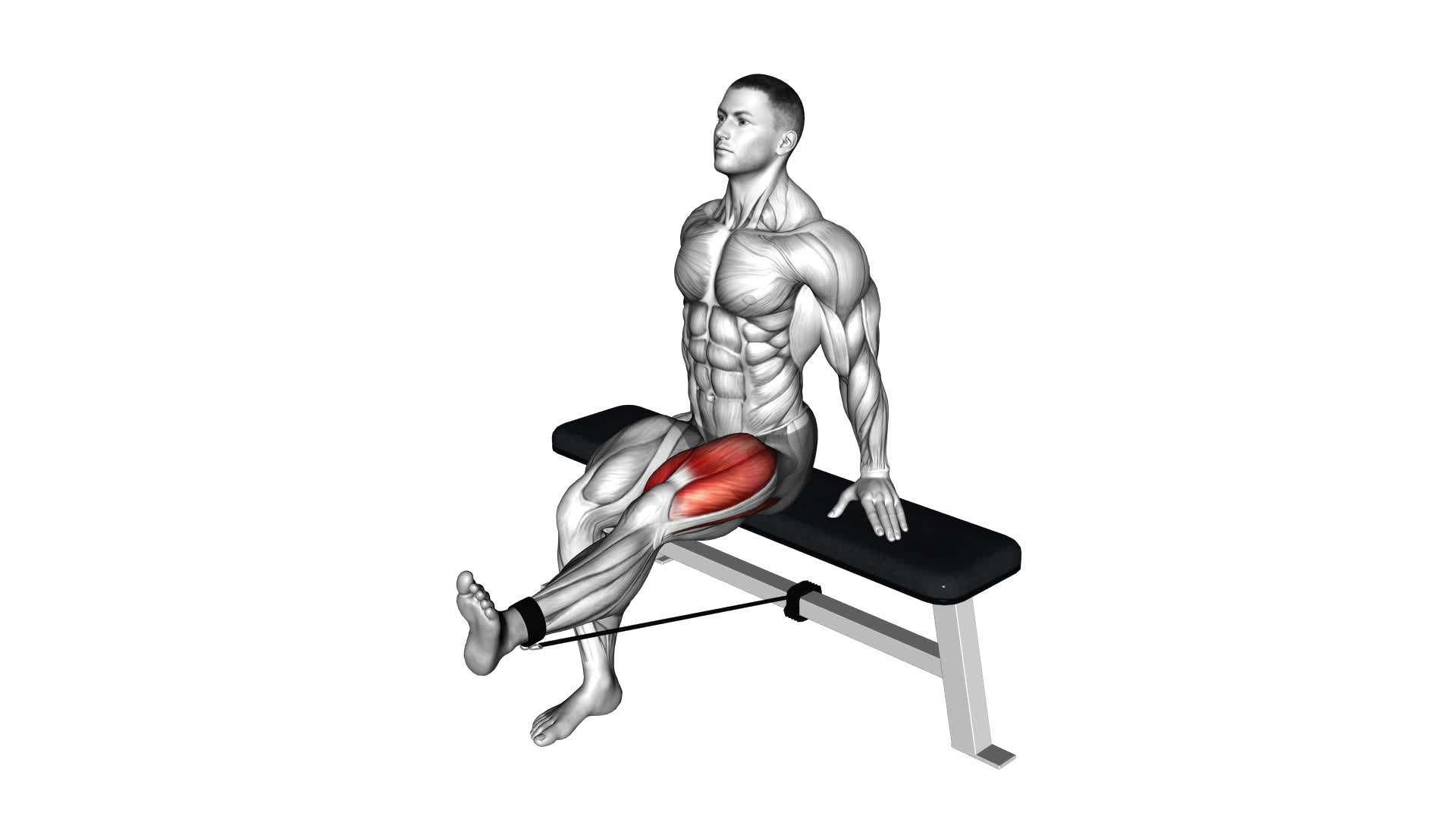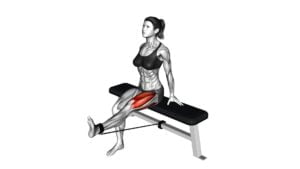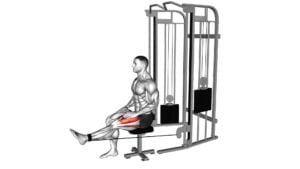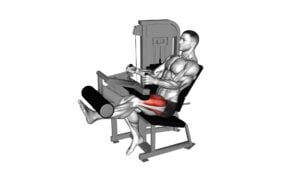Band Seated Leg Extension (male) – Video Exercise Guide & Tips

Are you looking to strengthen your leg muscles? The Band Seated Leg Extension is a great exercise for you! In this video guide, we'll walk you through the proper form and technique to ensure maximum effectiveness.
Watch This Exercise Video
You'll also learn about variations and progressions to challenge yourself as you get stronger. Avoid common mistakes and get the most out of this exercise with our helpful tips.
Let's get started!
Key Takeaways
- Band seated leg extension is highly effective for improving muscle strength, specifically targeting the quadriceps.
- The use of a resistance band increases the intensity of the exercise and helps improve muscle definition in the legs.
- Proper foot placement, including positioning feet shoulder-width apart and keeping toes pointing forward, is important for stability and to avoid knee injuries.
- It is important to avoid excessive knee extension and maintain controlled and smooth movements throughout the exercise.
Benefits of Band Seated Leg Extension
To maximize the effectiveness of your leg workout, you can experience the benefits of band seated leg extension by incorporating this exercise into your routine.
This exercise is highly effective for improving muscle strength and preventing knee injuries. The band seated leg extension specifically targets the quadriceps, which are the muscles located on the front of your thighs. By using a resistance band, you can increase the intensity of the exercise and challenge your muscles even more. This helps to improve muscle strength and definition in your legs.
In addition to strengthening your muscles, the band seated leg extension also helps to prevent knee injuries. The exercise targets the quadriceps, which play a crucial role in stabilizing the knee joint. By strengthening these muscles, you can reduce the risk of knee injuries, such as ligament tears or strains.
Incorporating the band seated leg extension into your leg workout routine is a great way to maximize your results. By improving muscle strength and preventing knee injuries, you can enhance your overall leg fitness and performance.
Equipment Needed for the Exercise
You'll need a resistance band for the band seated leg extension exercise. This equipment is essential for adding resistance to the movement and targeting your leg muscles effectively. The resistance band provides a challenging workout that helps improve strength and muscle tone in your quadriceps.
When performing the band seated leg extension, it's important to ensure that you have the proper form and technique. Start by sitting on a sturdy chair with your back straight and your feet flat on the floor. Place the resistance band around your ankles and secure it tightly.
Next, extend one leg straight out in front of you, keeping your foot flexed. Slowly return your leg to the starting position without allowing the resistance band to slacken. Repeat this movement for the desired number of repetitions and then switch to the other leg.
Maintaining proper form and technique throughout the exercise is crucial for maximizing its benefits and minimizing the risk of injury. Keep your core engaged, maintain a controlled movement, and avoid jerking or swinging your legs. Remember to breathe naturally throughout the exercise.
With the resistance band and proper form, the band seated leg extension can be an effective exercise for strengthening your quadriceps and improving lower body strength.
Proper Form and Technique
To perform the band seated leg extension exercise with proper form and technique, there are two key points to keep in mind.
First, foot placement is important. Make sure your feet are firmly planted on the ground and aligned with your knees to maintain stability and prevent injury.
Second, avoid excessive knee extension by not fully straightening your legs at the top of the movement to protect your joints and engage your muscles effectively.
Foot Placement Importance
Place your feet in the correct position to ensure proper form and technique during the Band Seated Leg Extension exercise. Proper foot placement is essential for maximizing the effectiveness of this exercise and preventing injury.
Here are some foot placement techniques to keep in mind:
- Position your feet shoulder-width apart to maintain stability and balance.
- Keep your toes pointing forward throughout the movement to target the quadriceps effectively.
- Place the balls of your feet firmly on the footplate, ensuring that your heels aren't lifting off.
- Avoid placing your feet too high or too low on the footplate, as this can lead to improper alignment and strain on the knees.
- Maintain a neutral foot position, neither excessively flexed nor overly extended, to promote proper muscle engagement.
Avoiding Excessive Knee Extension
Maintain proper form and technique during the Band Seated Leg Extension exercise by ensuring that your knees don't excessively extend. This is important to avoid knee injuries and to perform the exercise correctly.
When performing the leg extension, be mindful of your range of motion and avoid forcefully straightening your legs at the top of the movement. Instead, focus on a controlled and smooth motion, keeping a slight bend in your knees throughout the exercise.
This modification can help beginners perform the exercise safely and effectively. By avoiding excessive knee extension, you can protect your joints and reduce the risk of strain or injury.
Remember to always listen to your body and start with lighter resistance bands or lower weight if needed.
Variations and Progressions
As you progress in your band seated leg extension exercises, you can incorporate variations to challenge your muscles even more. Here are some variations and progressions you can try:
- Increase resistance: Use a stronger resistance band or add more bands to increase the resistance and make the exercise more challenging.
- Tempo variations: Change the tempo of the exercise by slowing down the movement on the eccentric phase or holding the contraction at the top for a few seconds.
- Single-leg extensions: Instead of using both legs simultaneously, try doing the exercise with one leg at a time. This will engage your muscles differently and provide a greater challenge.
- Seated leg extension with a stability ball: Sit on a stability ball instead of a chair or bench while performing the leg extension. This will engage your core muscles and challenge your balance.
- Weighted leg extension: Hold a dumbbell or ankle weights while performing the leg extension to add extra resistance and increase the difficulty.
Incorporating these variations and progressions into your band seated leg extension routine will help you continue to challenge and strengthen your muscles. Remember to start with lighter resistance and gradually increase as you become more comfortable and confident with the exercises.
Common Mistakes to Avoid
When performing the band seated leg extension, it's important to avoid overextending your knees, as this can put unnecessary strain on your joints.
Additionally, using excessive weight can compromise your form and increase the risk of injury.
Make sure to prioritize proper form and technique, focusing on contracting your quadriceps without using momentum.
Overextending the Knees
Avoid overextending your knees during the band seated leg extension exercise. Overextending your knees can put unnecessary stress on the knee joint and increase the risk of injury. To maintain knee joint health and ensure proper muscle activation, follow these tips:
- Keep your back straight and engage your core muscles.
- Maintain a controlled and steady movement throughout the exercise.
- Stop the movement just before your knees are fully extended to avoid hyperextension.
- Focus on squeezing your quadriceps (front thigh muscles) at the top of the movement.
- Use a resistance band that provides enough challenge without causing strain on your knees.
Using Excessive Weight
Are you using too much weight during the band seated leg extension exercise? While it may be tempting to load up the resistance, using excessive weight can actually hinder your progress and increase the risk of injury. It's important to find the right balance by using the correct resistance that challenges your muscles without compromising your form. Consider modifying the exercise by using a lighter resistance band or decreasing the number of repetitions. By doing so, you can ensure that your muscles are properly engaged and that you're able to maintain proper form throughout the exercise.
Neglecting to use the correct resistance can lead to ineffective results and potential strain on your joints.
Now let's move on to the next common mistake: neglecting proper form.
Neglecting Proper Form
To ensure optimal results and prevent injury, it's crucial to maintain proper form throughout the band seated leg extension exercise. Neglecting proper form can lead to common errors and increase the risk of injury. Here are some mistakes to avoid:
- Using momentum: Swinging your legs instead of controlling the movement can put strain on your joints.
- Rounding your back: Arching your back or hunching your shoulders can lead to back pain and poor posture.
- Lifting your hips: Keep your hips firmly planted on the seat to target your quadriceps effectively.
- Jerking the band: Avoid sudden movements or jerking the band, as it can strain your muscles.
- Overextending your knees: Don't lock your knees at the top of the movement to prevent knee strain.
By avoiding these common errors, you can ensure proper form and reduce the risk of injury.
Now, let's move on to some tips for maximizing the effectiveness of the exercise.
Tips for Maximizing the Effectiveness of the Exercise
To maximize the effectiveness of the Band Seated Leg Extension exercise, use a moderate resistance band. This will ensure that you're challenging your leg muscles enough to see results, but not overloading them and risking injury. Using a resistance band that's too light may not provide enough resistance to effectively work your leg muscles, while using one that's too heavy can put excessive strain on your joints.
In addition to using a moderate resistance band, it's important to focus on maintaining proper form throughout the exercise. Keep your back straight against the seat, engage your core muscles, and avoid using momentum to lift your legs. This will help to isolate and target the muscles in your legs more effectively.
To maximize your results, aim to perform the Band Seated Leg Extension exercise with slow and controlled movements. This will ensure that you're fully engaging your leg muscles throughout the entire range of motion. It's also important to listen to your body and adjust the resistance or number of repetitions as needed.
Remember to always warm up before starting the exercise and cool down afterwards to prevent injury. If you experience any pain or discomfort during the exercise, stop immediately and consult a healthcare professional. By following these tips and precautions, you can maximize the effectiveness of the Band Seated Leg Extension exercise and achieve your fitness goals.
Frequently Asked Questions
How Many Sets and Repetitions Should Be Performed for the Band Seated Leg Extension Exercise?
To get the most out of the band seated leg extension exercise, it's important to know how many sets and repetitions to perform. The number of sets and reps can vary depending on your fitness goals and level of experience.
Generally, it's recommended to start with 2-3 sets of 10-15 repetitions. This exercise targets your quadriceps, helping to strengthen and tone your legs.
It can also be modified by using different resistance bands or adding ankle weights for added challenge.
Can the Band Seated Leg Extension Exercise Help in Building Muscle Mass in the Legs?
The band seated leg extension exercise can definitely help in building muscle mass in your legs. Using resistance bands adds an extra level of difficulty, which increases the intensity of the exercise and activates more muscles.
The benefits of using band resistance for leg exercises include improved strength and muscle definition. There are also variations of seated leg extension exercises that can be done using resistance bands, allowing you to target different areas of your legs.
Is It Necessary to Warm up Before Performing the Band Seated Leg Extension Exercise?
Before performing the band seated leg extension exercise, it's highly recommended to warm up. Warming up prepares your muscles for the workout and helps prevent injury. If you're looking for alternative warm-up exercises, you can try jogging in place, doing jumping jacks, or performing bodyweight squats.
Incorporating resistance bands in your warm-up routine can also provide additional benefits such as activating your leg muscles and increasing blood flow. So, don't skip the warm-up and reap the benefits of a safer and more effective workout.
Can This Exercise Be Modified for Individuals With Knee or Hip Issues?
To modify the band seated leg extension exercise for individuals with knee issues, you can try using a lighter resistance band or reducing the range of motion. This will help to alleviate stress on the knees.
For those with hip issues, you can try placing a cushion or folded towel under the hips to provide extra support and reduce discomfort.
Always listen to your body and consult with a healthcare professional for personalized modifications.
How Often Should the Band Seated Leg Extension Exercise Be Included in a Workout Routine for Optimal Results?
For optimal results, how often should you include the band seated leg extension exercise in your workout routine?
Including the band seated leg extension exercise a few times a week can help promote leg muscle growth. This exercise targets your quadriceps, helping to strengthen and tone your legs.
Conclusion
To conclude, the band seated leg extension is a beneficial exercise that targets the leg muscles. With the right equipment and proper form, this exercise can help increase leg strength and improve overall lower body stability.
By avoiding common mistakes and following the recommended variations and progressions, individuals can maximize the effectiveness of this exercise. Incorporating this exercise into a well-rounded fitness routine can lead to improved leg strength and function.

Author
Years ago, the spark of my life’s passion ignited in my mind the moment I stepped into the local gym for the first time. The inaugural bead of perspiration, the initial endeavor, the very first surge of endorphins, and a sense of pride that washed over me post-workout marked the beginning of my deep-seated interest in strength sports, fitness, and sports nutrition. This very curiosity blossomed rapidly into a profound fascination, propelling me to earn a Master’s degree in Physical Education from the Academy of Physical Education in Krakow, followed by a Sports Manager diploma from the Jagiellonian University. My journey of growth led me to gain more specialized qualifications, such as being a certified personal trainer with a focus on sports dietetics, a lifeguard, and an instructor for wellness and corrective gymnastics. Theoretical knowledge paired seamlessly with practical experience, reinforcing my belief that the transformation of individuals under my guidance was also a reflection of my personal growth. This belief holds true even today. Each day, I strive to push the boundaries and explore new realms. These realms gently elevate me to greater heights. The unique combination of passion for my field and the continuous quest for growth fuels my drive to break new ground.







